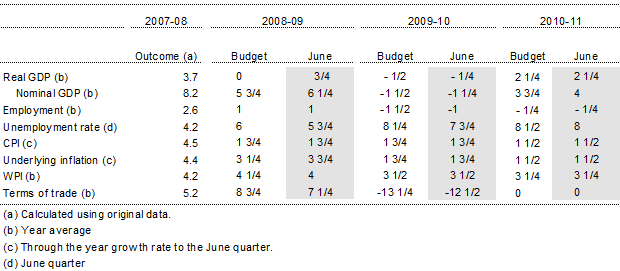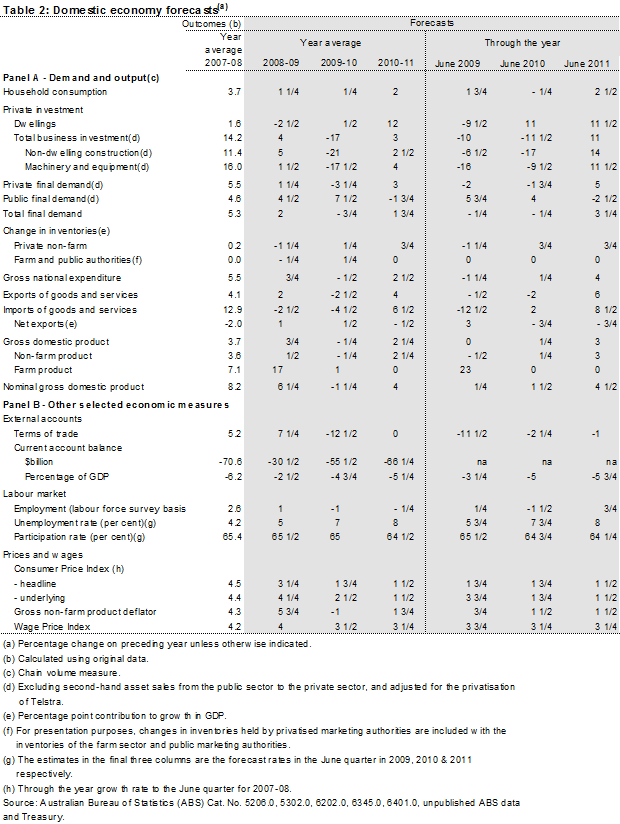The June round forecasts for the Australian economy are slightly more optimistic than Budget. The stronger than expected GDP growth outcome in the March quarter has pushed up our growth forecast for 2008-09, but a recession is still expected in 2009-10, albeit a slightly less severe one. In line with the stronger economy, the unemployment rate is now forecast to peak a little lower, at 8 per cent.
The world economy remains fragile, with the first quarter of 2009 recording even worse outcomes in many advanced economies than the record declines the previous quarter. However, the outlook for some emerging economies has improved slightly since Budget. While many advanced economies are in deep recession, there are signs that the global economy may be stabilising.
World GDP is expected to contract by 1½ per cent in 2009 before a modest recovery begins in 2010, unchanged from Budget. However, major trading partner growth has been revised down by ¼ of a percentage point from Budget to a decline of 2¼ per cent in 2009, reflecting downgrades to Japan and other east Asia, but is expected to recover at a slightly stronger pace in 2010.
Data on the Australian economy have been more positive than expected at Budget but the additional volatility at this time suggests these results should be interpreted with caution. GDP grew by 0.4 per cent in the March quarter, a 0.8 percentage point turn-around from that expected at Budget. The labour market has also held up better than expected, with the unemployment rate now unlikely to reach 6 per cent by June 2009 as forecast at Budget. And while the outlook for the global economy remains broadly unchanged, the better than expected performance of China and India translates into an improved outlook for exports. Exports held up better than expected in the March quarter and appear likely to do so again in June. We continue to expect a decline in export volumes but there is a possibility that exports of coal and iron ore will hold up better than forecast.
GDP growth forecasts for Australia have been revised up to growth of ¾ per cent in 2008-09 and a more moderate decline of ¼ per cent in 2009-10, up from a decline of ½ per cent at Budget. The outlook for 2010-11 remains unchanged, with the economy expected to begin a modest recover in that year, growing by 2¼ per cent.
Table 1: Key Domestic Forecasts – June compared with Budget

Source: ABS Cat. No. 5206.0, 6345.0, 6401.0, 6202.0 and Treasury.
Business investment contracted in the March quarter in line with Budget expectations, although the pipeline of work for commercial property projects is holding up slightly better than expected at Budget. Having peaked as a share the economy, business investment is still expected to fall significantly, by 17 per cent in 2009-10, a slight improvement from Budget.
The Government's cash payments to households and sharply lower interest rates have lent much needed support to households affected by sharp declines in household wealth and fears of impending job losses. The boost to household incomes and consumption growth experienced in the December quarter gathered pace in the March quarter, with household consumption growing by 0.6 per cent, the best performance since the March quarter 2008. While underlying consumption is expected to remain very weak over 2009-10 as household's focus on rebuilding savings, policy actions already in place will continue to support consumption over the next 6 months.
The forecasts for the public sector are little changed from Budget. They are driven by the stimulus packages announced since October last year and are a key source of growth in 2009-10. As at Budget, slippage of spending profiles remains the key risk to public sector forecasts and a risk to GDP growth in 2009-10.
Partial data in the dwelling sector are pointing to a turnaround in the sector as expected at Budget with a recovery likely to begin in the second half of 2009. Dwelling investment is particularly responsive to low interest rates and the other fundamentals of the sector remain solid, (limited supply combined with strong population growth and high rents). The Governments FHOB has resulted in a large number of first home buyers entering the market. The broader investor market remains cautious but strong fundamentals combined with encouraging recent leading indicators suggest a recovery in dwelling investment will begin in the second half of 2009. Importantly, these same factors are acting to support house prices although more sustained declines in prices remain a key risk to these forecasts.
The usual risks associated with economic forecasting have been amplified in the current environment by large swings in key aggregates and the divergence of growth measures published by the ABS. The divergence in the published measures of GDP growth in the December quarter increased further in the March quarter, with estimates ranging from a decline of 0.9 per cent for GDP(P) to an increase of 1.1 per cent for GDP(E). Given the sharply shifting base, shorter term forecasts are subject to even greater uncertainty.
On balance, the economic news appears to be improving and while international and domestic measures of confidence remain low, they have improved. However, given volatility in the economic data at present and likely further adjustments in exports and business investment, Australia still has some difficult economic terrain to navigate.
Table 2: Domestic Economy Forecasts (a)
